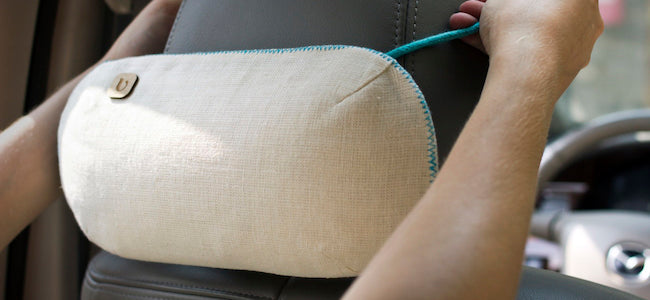The Definitive Guide to Bamboo Charcoal

Bamboo charcoal has gotten a lot of attention recently, and for good reasons. To understand everyone’s fascination with this super material, learn more about its uses, and find out exactly what it is and how it works, just keep on reading :). This is the Definitive Guide to Bamboo Charcoal.
Why Is Everyone Excited About Bamboo Charcoal?

For centuries, bamboo charcoal has been a popular filtration medium and component of medicine in Asia, especially Japan, China, Korea, and Taiwan. However, the uses and benefits of this material have become evident to Westerners in recent years. It’s an effective, environmentally friendly deodorizer and purifier with a plethora of additional uses.
Natural Deodorizer

Conventional air fresheners mask bad odors, which usually does more harm than good. How often has your artificially scented apple/flower/sea breeze air freshener turned into a revolting blend of sweaty feet with just enough sweetness to make you gag?
Bamboo charcoal adsorbs and removes odor without trying to cover horrible smells with cloying perfume. What’s more, that sickly sweet air freshener contains chemicals that are not only harmful to people, animals, and the environment, but also tend to trigger asthma attacks and allergic reactions.
Removing horrible smells without causing new ones is especially useful in cars and other small spaces. Instead of subjecting yourself to the delightful scent of wet dog and lavender, you can use a bamboo charcoal car deodorizer that removes the stink instead of adding to it. This super material won’t make you, your passengers, and your trusty four-legged friend choke on chemical fumes.

Purggo Car Air Eco-Purifier Made with Bamboo Charcoal
Bamboo charcoal is natural, fragrance-free, allergen-free, and non-toxic. Activated bamboo charcoal air fresheners, such as the all-natural Purggo Car Eco-Purifier, are safer, healthier, and last significantly longer than conventional ones do.
Leaving activated carbon in the sun for an hour or two once a month removes any moisture it absorbed and refreshes it, and these air fresheners last for more than a year.
You can also use charcoal to spruce up your bedroom, bathroom, fridge, and freezer; freshen your gym bag, footwear, hockey and sports equipment, and eliminate offensive smells emanating from pet areas and diaper and compost pails. Alternatively, use it to get rid of the smell of paint and other chemicals in newly renovated parts of your home.
Keeps You Breathing Easy

In addition to removing odors, bamboo charcoal also purifies air by removing pollutants from the atmosphere. It adsorbs ammonia, carbonic oxide, benzopyrene, and other components of smog, and lowers the concentration of environmental contaminants that trigger allergies and asthma.
Charcoal is added to air filters to remove harmful chemicals in commercial and industrial settings, and some enclosed cat litter boxes even come with air vents covered with charcoal filters that neutralize odors by adsorbing ammonia.
Improve Water Quality

Bamboo charcoal purifies water by removing pollutants and improves water quality by releasing minerals. When placed in water, charcoal softens the water, absorbs harmful chemicals like chlorine, and releases calcium, magnesium and other natural minerals.
Activated carbon is a popular filter medium in tropical aquariums because it improves water quality and removes nitrogen and toxic products created by aquatic life. Drop a small piece of activated bamboo charcoal into a jug or glass to filter drinking water, or be kind to your skin and add some to your bathwater to soften the water.
Myriad of Uses In and Around the House

The porous structure of bamboo charcoal makes it an ideal dehumidifier. It adsorbs atmospheric moisture and releases it back into the atmosphere when humidity levels drop. You can use it in drawers, closets, and cabinets to keep clothing and linens fresh, or in the basement, garage, or storage area to prevent mold. Keep some in the crisper drawer to extend the lifespan of fruit and vegetables by two to three days.
Bamboo charcoal has a high mineral content and is an excellent source of potassium, sodium, calcium, and iron, which it releases when used as a fertilizer or water purifier. It helps aerate soil and acts as a moisture regulator in the garden by retaining excess water and releasing it when the soil dries. When your bamboo charcoal air freshener reaches the end of its useful life, you can remove the charcoal from the bag and use it as fertilizer and a natural insecticide for your indoor plants, your lawn, or your garden.
Activated charcoal is even good for your skin. Several soaps and beauty products, such as Herbivore Botanicals Bamboo Charcoal Soap, Mt. Sapola’s Charcoal Soap, and Raw Materials Spot Fix Soap, rely on charcoal to remove bacteria, toxins, and impurities from skin.
Is Bamboo Charcoal Safe?
You can use bamboo charcoal around kids and pets with complete ease of mind because charcoal is harmless even if eaten. In fact, many people in Asia take charcoal tablets to deal with stomach ailments, and it’s safe to use on pets. The tablets absorb poisons, allowing gastric toxins to pass through the system without the need to use synthetic medicines.
What Exactly is Bamboo Charcoal?

In simple terms, bamboo charcoal is charcoal derived from bamboo. Most people are familiar with the charcoal used to barbeque, but few know exactly what it is or how it’s made. Charcoal is carbon created through a heating process that takes non-carbon material out of plant or animal matter. Although the process sounds complicated, it simply involves heating bamboo (or some other material) in a kiln to a specific temperature before removing the oxygen supply.
Bamboo charcoal has a massive surface area to mass ratio, and a single gram of bamboo charcoal has as much as 600 square meters (or 717.6 square yards) of surface area. Activated bamboo charcoal takes this a step further.
The activation process can double the surface area to a whopping 1,200 square meters (1,435 square yards) per gram. The activation process, patented in South Korea, is a well-kept secret, but involves granulating the charcoal and passing steam through the granules. Regular bamboo charcoal and activated charcoal have the same adsorption abilities, but activated carbon better holds the substances it adsorbs.
How Does Bamboo Charcoal Work?

Bamboo charcoal’s natural adsorption characteristics coupled with its significant surface area make it an effective adsorbent. Its millions of pores can trap and store vast amounts of pollutants and other harmful substances. Charcoal adsorbs odor and pollutant particles by trapping them while air or water flows through the pores, purifying the surrounding air or water in the process.
Bamboo charcoal is four times more porous than regular wood charcoal, which significantly increases its effectiveness.
Adsorption vs. Absorption
When reading about charcoal, you’ll often come across the word ‘adsorption’. This is not a typo. During adsorption, charcoal attracts substances, which cling to and accumulate on its surface. In contrast, absorption (with a “b”) involves one substance diffusing into another without any special attraction. A rag absorbs water due to the nature of its fibers, not because of physical attraction.
Still Skeptical? Check the Science
Scientific research supports the effectiveness of bamboo charcoal in odor control and the removal of harmful atmospheric gases.
“Science of Bamboo Charcoal: Study on Carbonizing Temperature of Bamboo Charcoal and Removal Capability of Harmful Gases,” a study conducted at Nagaoka University of Technology in Japan and published in the Journal of Health Science, yielded overwhelmingly positive results.
The researchers tested charcoal carbonized at different temperatures and focused on the adsorption of chemicals known to cause “Sick Building Syndrome,” specifically formaldehyde, toluene, and benzene. They found that charcoal adsorbs formaldehyde when carbonized at most temperatures. Testing with nonenal, a type of odorant, revealed the following:

The researchers concluded “charcoal can be used effectively as a countermeasure against Sick Building Syndrome or as a deodorant.”
Is Bamboo Sustainable?

Bamboo is becoming an increasingly popular material with environmentally conscious consumers because it’s one of the most sustainable resources available. As long as farmers harvest it responsibly, bamboo can regenerate itself indefinitely without human intervention or synthetic fertilizer, herbicides or pesticides.
Moso bamboo, the most popular type used in commercial applications, is the largest of the subtropical timber bamboos, growing to a height of up to 75 feet and a 7-inch diameter at maturity. It takes only five years for plants to mature. Plants grow 40 to 50 feet within the first few months and can grow over 3 feet a day in their native habitat. This bamboo is used for everything from fashion to flooring to paper (and, of course, to make activated bamboo charcoal).
In addition, the plant’s young shoots, which have a delicate flavor, form an important part of Japanese cuisine.
Gotta Love It

Bamboo charcoal is an environmentally friendly and ecologically responsible replacement for chemical and synthetic deodorizers, purifiers, and fertilizers. It releases valuable minerals, is 100% natural, and is safe to use around pets, children, and people with allergies or asthma.
Scientific studies support charcoal’s adsorption abilities, and it has numerous uses in commercial and household applications. Best of all, you can use activated charcoal with confidence – it’s good for you and the environment from cultivation to disposal.






